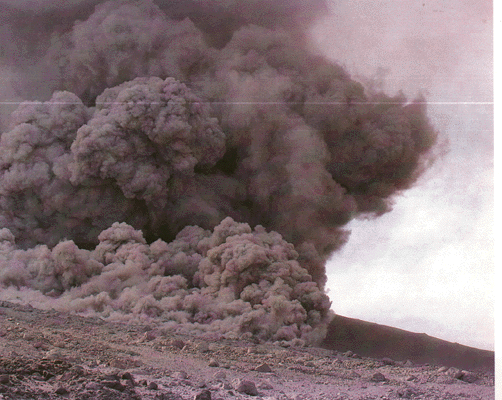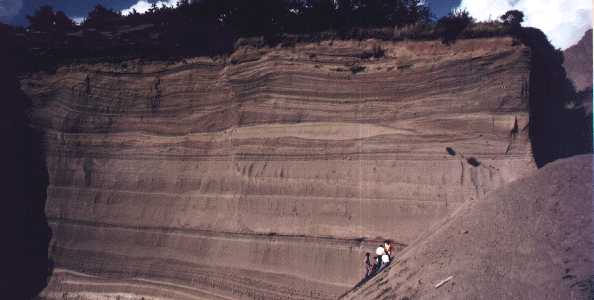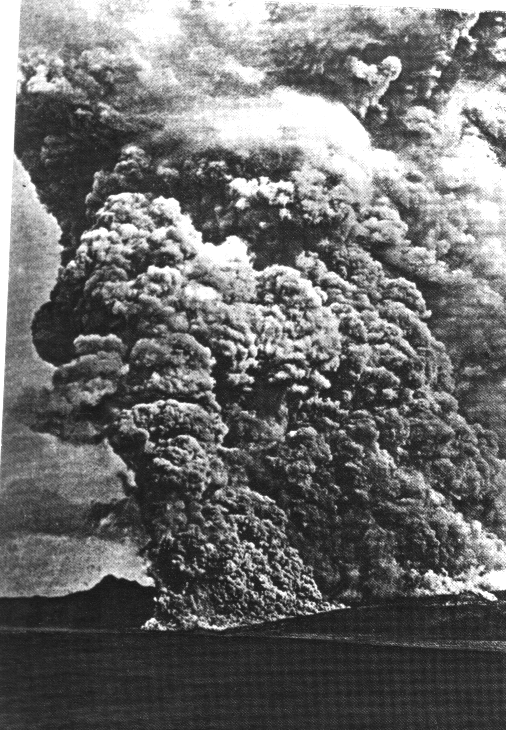

Pyroclastic flows are one kind of sediment gravity flow. Sediment gravity flows are unique fluids because properties such as density and viscosity can change as they move, unlike fluids such as water or air within which density and viscosity change very little, if at all, during movement.
The driving force of a sediment gravity flow is the action of gravity upon the particles. Sediment motion moves the interstitial fluid (gas or liquid mixed with fine particles), and together they constitute the fluid mass. Particles with different settling velocities, however, behave differently within the mass. Very small particles tend to couple with the gas phase because of drag effects (Sparks, 1976), thereby greatly increasing the carrying capacity of the current. This particulate-gas-phase matrix may move in turbulent flow lines and entrain larger fragments, though fragments with the higher settling velocities tend to migrate toward the base of the flow thereby increasing fragment concentration and causing an increase in bulk density and an increase in effective viscosity (Fisher, 1966).
The collapse of vertical eruption columns to form pyroclastic flows was recognized at the 1929 eruption of Komagatake, Japan (Kozu,1934) and postulated from sedimentological data at St. Vincent, B.W.I. by Hay (1959). Using development of a base surge from a 1947 nuclear explosion at Bikini Atoll (south Pacific) as a model, column collapse ("bulk subsidence") was suggested as a cause of pyroclastic flows leading to development of ignimbrites by Fisher (1966), and the process of column collapse was described from a series of photographs showing the development of a surge at Capelinhos (Azores) (Waters and Fisher, 1971). The connection between column collapse and the origin of pyroclastic flow and surge deposits was quantitatively established by Sparks and Wilson (1976) and Sparks et al. (1978). Some pyroclastic flows and surges, however, originate without accompanying vertical eruption columns. For example, at Mount St. Helens on 22 July and 7 August, 1980, pyroclastic density currents began as fountains of gases and pyroclasts around the vent prior to development of a vertical eruption column.

Volcanologists first became aware of pyroclastic flows in 1902 at Mont Pelée Martinique where 29,000 people died. LaCroix (1904) applied the name nuée ardente to the flows, pointing out the co-existence of a basal "glowing avalanche" (higher density basal flow) and a dilute upper lower density "glowing" cloud. The flow separated during flowage, the dense basal part forming a rheological mass that became essentially non-turbulent and followed the valley of Rivière Blanche, while the upper dilute part, being depleted in fragment population, remained turbulent and spread out fan-shaped across the terraces and hills at the foot of the volcano to overwhelm the town of St. Pierre.
Dense pyroclastic flows follow valleys; dilute pyroclastic flows are able to cross valleys, hills and mountains. They are able to surmount high mountain ranges, as illustrated by the Campanian Ignimbrite located in the Naples region of Italy.
The flow dynamics within a single sediment gravity flow can change during movement by gravity separations of particles that continuously change particle concentration and therefore the density and viscosity properties. As a result of changing flow regime, sediment gravity flows exhibit (1) "flow transformations" where changes in the ratio of fluids to granular materials (density, viscosity) change turbulent to laminar flow behavior (Fisher, 1983, 1984), (2) "density stratification" (Valentine, 1987) because of gravitational settling, and (3) "decoupling" of a current into more than one current, each with different flow properties (Fisher, 1990, 1995).
As a pyroclastic flow moves along the ground, gravity pulls at each particle, causing larger, heavier ones to migrate downward faster than smaller, lighter ones despite random collisions with other particles that may jolt them upward or downward even as they move forward with the mass. As the heavier particles filter downward, the upper part of the current becomes increasingly depleted in particles (more dilute). The dilute part of the flow can remain turbulent and maintain particles in suspension and decouple from the lower part. The lower part of the current becomes increasingly dense and less turbulent to non-turbulent, and particles begin to deposit onto an aggrading surface. As particles continue to come to rest on the upward aggrading surface, a layer of ever-increasing thickness is deposited.
Differences in density, velocity and flow regimes between the nonturbulent and turbulent parts of a pyroclastic flow can result in a boundary separation between them. The upper part of a current can shear across and separate (decouple) from the lower part or vice versa. The two parts are then able to travel separate paths.
Decoupling of of pyroclastic currents into a lower part containing most of the solid fragmental mass (the "glowing avalanche") and an overriding expanding cloud of ash (the "glowing cloud"), together known as a nuée ardente, has been witnessed or attested by several workers (Anderson and Flett, 1903; LaCroix, 1904; Perret, 1937; Taylor, 1958; Smith, 1960; Davies et al., 1978; Nairn and Self, 1978). Decoupling of a single current can result in formation of pyroclastic flow and pyroclastic surge deposits from the same initial current.
Bogoyavlenskaya, G.E., Braitseva, O.A., Melekestsev, I.V., Kiriyanof, V. Yu, and Miller, C.D., 1985. Catastrophic eruptions of the directed-blast type at Mount St. Helens, Bezymianny and Shiveluch volcanoes. Journal of Geodynamics, 3, 189-218.
Davies, D.K., Quearry, M.W. and Bonis, S.B., 1978. Glowing avalanches from the 1974 eruption of the volcano Fuego, Guatemala. Geol. Soc. Amer. Bull. 89, 369-384.
Fisher, R.V., 1966. Mechanism of deposition from pyroclastic flows. Amer. J. Sci. 264, 350-363.
Fisher, R.V., 1971. Features of coarse-grained, high-concentration fluids and their deposits. J. Sed. Petrol. 41, 916-927.
Fisher, R.V., 1983. Flow transformations in sediment gravity flows. Geology 11, 273-274.
Fisher, R.V., 1984. Submarine volcaniclastic rocks. In Kokelaar, B.P. and Howells, M.F. (eds), Marginal basin geology: volcanic and associated sedimentary and tectonic processes in modern and ancient marginal basins. Spec. Publ. Geol. Soc. London 16, 5-27.
Fisher, R.V., 1990. Transport and deposition of a pyroclastic surge across an area of high relief: The 18 May 1980 eruption of Mount St. Helens, Washington. Geol. Soc. America Bull. 102, 1038-1054.
Fisher, R.V., 1995. Decoupling of pyroclastic currents and hazards assessments. Special Issue, Glicken Volume, Jour. Volcanol. Geotherm. Res., v. 66, p. 257-263.
Hay, R.L., 1959. Formation of the crystal-rich glowing avalanche deposits of St. Vincent, B.W.I. J. Geol. 67, 540-562.
Hoblitt, R.P., 1986. Observations of eruptions, July 22 and August 7, 1980, at Mount St. Helens, Washington. U.S. Geol. Surv. Prof. Paper 1335, 1-43.
Kozu, S., 1934. The great activity of Komagatake in 1929. Tschermak's Mineral. Pet. Mitt. 45, 133-174.
Lacroix, A., 1904. La Montagne Pelé et ses eruptions. Masson et Cie, Paris, 1-662.
Mellors, R.A., Waitt, R.B. and Swanson, D.A., 1988. Generation of pyroclastic flows and surges by hot-rock avalanches from the dome of Mount St. Helens volcano, U.S.A. Bull. Volcanol. 50, 14-25.
Middleton, G.V. and Hampton, M.A., 1976. Subaqueous sediment transport and deposition by sediment gravity flows, inD.J. Stanley and D.J.P. Swift, eds., Marine sediment transport and environmental management. John Wiley, New York, p. 197-218.
Nairn, I.A. and Self, S., 1978. Explosive eruptions and pyroclastic avalanches from Ngauruhoe in February, 1975. J. Volc. Geotherm. Res. 3, 39-60.
Perret, F.A., 1937. The eruption of Mt. Pelé 1929-1932. Carnegie Inst. Wash. Publ. 458, 1-126.
Siebert, L. Glicken, H. and Ui, T., 1987. Volcanic hazards from Bezymianny- and Bandai-type eruptions. Bull. Volcanol., 49, 435-459.
Smith, R.L., 1960. Ash flows. Geol. Soc. Amer. Bull. 71, 795-842.
Sparks, R.S.J., and Wilson, L., 1976. A model for the formation of ignimbrite by gravitational column collapse. J. Geol. Soc. London 132, 441-451.
Sparks, R.S.J., Wilson, L. and Hulme, G., 1978. Theoretical modeling of the generation movement and emplacement of pyroclastic flows by column collapse. J. Geophys. Res. 83, 1727-1739.
Taylor, G.A., 1958. The 1958 eruption of Mount Lamington, Papua. Austr. Bur. Min. Resour. Geol. Geophys. Bull. 38, 1-117.
Valentine, G.A., 1987. Stratified flow in pyroclastic surges. Bull. Volcanol. 49, 616-630.